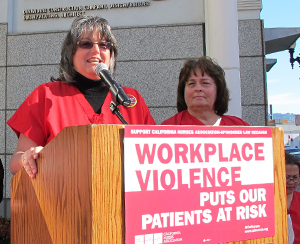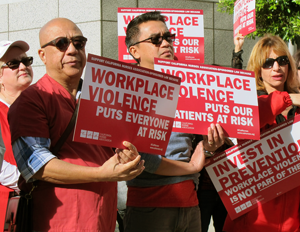Blog
RNs Rally in Support of Hospital Workplace Violence Regulations

“Hospitals say they are doing enough to protect nurses from violence, but they don’t have a plan,” said California Nurses Association Co-president Melinda Markowitz, RN.

Markowitz kicked off a press conference Wednesday in front of the Harris State Building, where over 50 RNs gathered for the final public hearing on new California Occupational Safety and Health Administration (Cal/OSHA) hospital workplace violence regulations. The nurses were there to show continued support for the regulations, as they move toward finalization in 2016, and to advocate—along the way—for the highest level of protections.
“Hospitals chronically understaff the facilities, which leaves nurses vulnerable to violence. That’s unacceptable, and that’s going to change,” Markowitz emphasized.
The upcoming regulations are the result of a CNA-sponsored bill, SB 1299—the Healthcare Workplace Violence Prevention Act—which was signed in 2014 by California Governor Jerry Brown. The bill mandates that hospitals have a comprehensive workplace violence prevention plan; Cal/OSHA’s regulations will implement the law.
After the rally, RNs filed into the Harris State Building, in a show of support during the public hearing itself. Several CNA nurses opened the meeting with personal testimony.

“Not once in the years that I’ve worked at California Pacific Medical Center have we been offered any adequate training on recognizing potential violent situations—or on demonstrating and practicing techniques to diffuse, deescalate or manage these all–too-common occurrences,” said Amy Erb, RN. “The culture in our workplace is one of complacency and indifference by management and administration. So we are here to show support for the strongest regulations that would hold hospitals and other healthcare facilities accountable for implementing a violence prevention plan.”
Mike Hill, RN, of Sutter Alta Bates Summit Medical Center, also spoke at the hearing. Sharing a personal account of violence in his facility, he explained that after a physical altercation between two families in the neonatal intensive care unit, a lack of staffing and adequate protocols caused a dangerous delay in addressing the violence.
“Despite security being called, the nurses and doctors had to break up the altercation. Police also had to be called because there were not enough security staff available,” said Hill. “This has become the norm, as nurses feel they are on their own in fighting this violence. These regulations emphasize prevention, which is the key.”
RNs cite the prevention aspect of California’s current legislation as a model for the nation.

“These draft regulations set a model for the rest of the country by emphasizing prevention. Some states emphasize criminalizing perpetrators, who are often mentally unstable patients, but we don’t believe locking up more mentally ill people is the answer,” says Markowitz. “It is the responsibility of hospitals to stop violence from happening in the first place.”
Nurses also laud the comprehensive nature of the proposed regulations, which cover healthcare workers working in any location where healthcare is being provided, including retail settings and out in the community-at-large (in the case of public health nurses).
With final input gathered, draft regulations will then move on toward finalization in 2016.